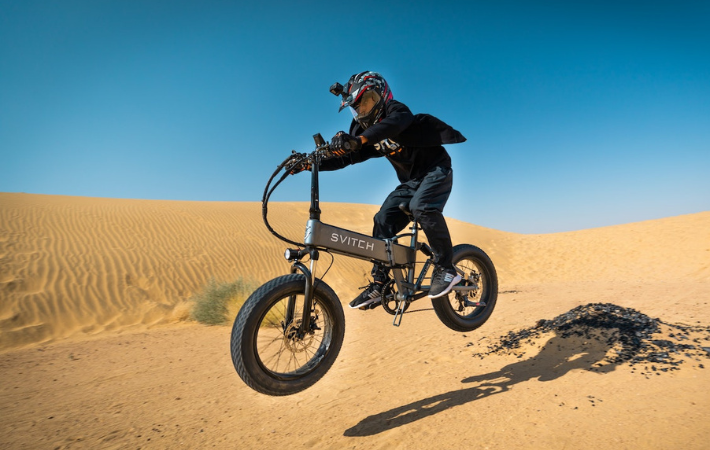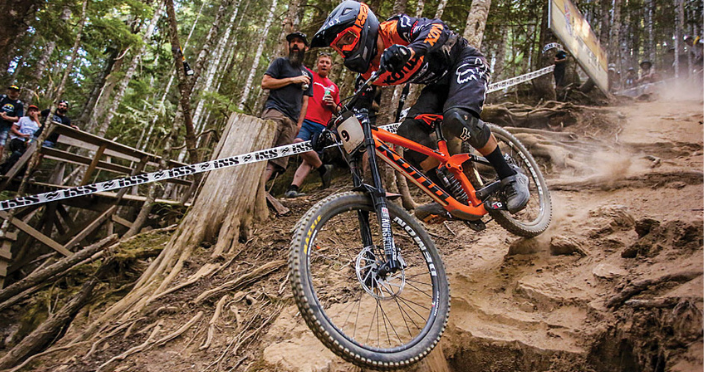Are you ready to take your electric mountain bike downhill at warp speed? Buckle up, because we’re about to unlock the secrets to descending faster and safer than ever before.
Here’s the game plan: We’re not just going to tell you how to hit the brakes less – we’re going to teach you about mastering the art of controlled chaos, all while sporting a big grin. We’ll get down and dirty with e-bike mechanics, spilling the beans on safety gear, dissecting rider techniques, and even chat about the wild cards – weather and terrain.
So, fasten your helmet, because you’re about to gain some serious downhill speed.
Understanding E-Bike Mechanics for Descending
Impact of Weight and Balance
Ever wonder how you can maintain control while hurtling downhill at the speed of a caffeinated cheetah?
It’s all about weight distribution. You and your e-bike need to be in perfect harmony. Think of it this way: If you’re like a sack of potatoes on your bike, you’ll get tossed around like a dinner salad.
Keep those knees and elbows bent equally, with your back nearly parallel to the ground. Make sure your head is up and your body is well-balanced both front to back and side to side. And, always try to maintain “light hands but heavy feet”. By shifting your body weight onto the pedals rather than your hands, your bike can better track the terrain, and you’ll experience less hand and forearm fatigue.
The Role of Suspension and Tires
Now, let’s talk briefly about the unsung heroes – the suspension and tires. These two are your shock-absorbing wingmen. They do their best to keep your ride smooth and grippy, no matter how wild things get.
The suspension system is your primary line of defense against the punishing impacts of rough terrain. It absorbs the jolts and bumps, allowing your wheels to maintain contact with the ground. This constant contact is the key to control and speed. If your suspension is properly set up, you’ll float over rocks and roots with ease, maintaining momentum and conquering these obstacles.
On the other hand, inadequate suspension can transform your descent into a bone-rattling ordeal, sapping your confidence and slowing you down.
Now, let’s not forget about your tires. The right tire choice and tire pressure can significantly impact your downhill performance. Wider, knobbier tires provide better grip and stability, helping you carve through corners and maintain control during high-speed descents.
Tire pressure is equally important. Too much pressure and your tires will bounce off obstacles, robbing you of traction. Too little, and you risk pinch flats or burping air on hard landings. Finding the sweet spot for your tire pressure ensures optimal grip and a smoother ride The best way to dial it in is through trial and error. Find what feels right for you.

Techniques for Faster Descending
Now, let’s dive into the heart-pounding techniques that’ll turn you into a downhill speed wizard. We’re talking about the secrets pro riders have spent years mastering – and we’re about to spill the beans.
Bike Setup – Where Speed Begins
Let’s kickstart our journey to downhill dominance with the cornerstone of speed – bike setup. Picture your e-bike as your trusty sidekick, ready to conquer the trails. But before the epic descent begins, you need to ensure your loyal steed is in tip-top shape.
- E-Bike Suspension – Begin with the suspension, the unsung hero that smooths out your ride. If your bike feels like it’s attempting to catapult you off at every bump, your rebound may be cranked up too high. Conversely, if it feels saggy or slow to bounce back, your rebound might be too sluggish. Dive into your bike’s suspension components, and if you’re rocking an air fork or shock like most riders, be sure to fine-tune that sag. Need expert guidance? Your local shop or the suspension manufacturer can provide you with that wisdom.
- The Cockpit – Speed isn’t just about raw power; it’s also about comfort and control. Experiment with stack heights, bar widths, and stem lengths until you find that Goldilocks setup that’s just right for you. Consider a brake lever orientation that keeps your wrists in a poised line. Don’t forget to choose grips that fit your hands like a glove. And for the grand finale, double-check that your stem is as straight as an arrow. We can’t tell you how many times we’ve saddled up a new bike and noticed that the stem was slightly askew – that’s just a recipe for disaster.
- Look Further Ahead – Ever wonder why pro riders seem to anticipate every twist and turn on the trail? It’s not because they have a crystal ball; they’ve mastered the art of looking further ahead. No more staring at your front tire like it’s a long-lost love – it’s time to look ahead like you’re watching a thriller movie. Fast riders know the importance of spotting trail features well in advance, and they’ve got some Jedi-level eye-steering skills. No more smashing into rocks because you couldn’t look away – we’ve all been there. When racing down those trails, focus on where you want to go, not where you don’t. You can even try pointing your chin toward your chosen line. It’s a friendly reminder to keep your head up and your eyes glued to the trail.
- Attack Position – The attack position is your secret weapon. Standing up gives you the power to conquer descents – absorbing terrain with your legs, shifting your weight through turns, and tackling those drops like a champ. Picture yourself standing tall over your bike, ready to take on the world. Your knees and elbows are in harmony, your back is almost parallel to the ground, and your head is high. This isn’t just a pose; it’s a position of strength. It calls upon your core, arms, and legs to work in unison.
- Stay Loose – Here’s a golden rule: a tense rider is never a fast rider. If you want to hit those downhill speeds, you’ve got to stay loose. You need to maintain that strong attack position, but loosening your grip on those handlebars is equally important. Let your bike groove underneath you. Our test riders swear by this mantra: “light hands, heavy feet.” Let the weight flow through your pedals instead of putting the weight on your handlebars. This little trick helps your bike stick to the ground like glue; your hands and forearms will thank you. We’re not talking about riding so loose that your bike thinks it can do whatever it wants, but we’re also not advocating the type of tension that turns your muscles into rocks and your bike into a wild stallion.
- Brake Early – Now, let’s debunk a myth – fast riders do use their brakes. But they use them with strategy. The trick here is to brake before the turn, not when you’re halfway through it. Fast riders anticipate their need for speed and plan their braking accordingly. On those straightaways, they give their brakes a gentle jab to scrub off speed instead of dragging them like a tug of war. Smoothness is your friend, and that starts with braking earlier than your instincts might suggest.
- Stop Pedaling So Hard – Here’s a temptation that often lures beginners – pedal, pedal, pedal! Many crank the pedals as if their life depended on it, thinking they’ll rocket down the trail. But here’s the truth: it’s not always the fastest way. Down steep singletrack, mashing on the pedals is like trying to win a sprint on a skateboard – it’s not the smartest move. Unless you’re a superhuman cross-country rider, pedaling like a maniac will leave you tired and making mistakes that’ll slow you down. So, take a deep breath and relax. Remember, smooth is the name of the game.
- Spot Faster Lines – Ever watched a race car gracefully glide around a track, cutting corners like a pro? It’s not just because they have a heavy right foot; they’ve mastered the art of spotting faster lines. While we’d never endorse going off the trail intentionally, we do suggest using the inside corners of the trail to your advantage. If you’ve struggled to find those speedy lines, follow a more experienced rider, mimicking their choices. As your confidence grows, unleash your inner trail whisperer and discover your unique lines to bridge the gap between you and the fastest riders. Always remember to respect fellow trail users and the environment. If someone’s climbing up the trail, yield the fast line – it’s just good trail karma.
- Practice, Practice, Practice – Now, don’t be disheartened if you don’t become an instant speed demon. Speed mastery takes time and practice. The more time you spend in the saddle, especially on challenging descents, your skills become sharper. Push your boundaries – tackle rougher and gnarlier trails than your usual stomping grounds. Don’t go over your skill level; dare to explore different trails with fresh obstacles. Remember, pro riders make it look easy because they’ve spent years perfecting their craft. If you want to join the speedster ranks, you’ve got to put in the work.
Safety Considerations for Rapid Descending
Essential Gear
As much as we’d love to think we’re invincible, we’ve got to be realistic here. Safety gear isn’t just for the cautious – it’s for the wise. We’re talking helmets that protect your noggin and gloves that give you the grip you so desperately need when speeding down a mountainside. Think of them as your armor against the forces of gravity.
Equipment Check
Now, make sure your e-bike is ready for the adventure. You wouldn’t head into battle with a rusty sword, would you? Run through the same checklist you normally would to ensure your trusty steed is ready for action.
Environmental and Terrain Considerations
Weather Conditions
Mother Nature’s mood swings can take your e-bike downhill journey from thrilling to chilling in no time. Whether she’s crying buckets, basking in the sun, or sending a surprise snowstorm, you better believe it’ll impact your descent.
- Raining Buckets – Rain can transform the trails into a slippery slope. The moist terrain demands ninja-like finesse. Tires grapple with reduced grip, and your brakes become less effective. Simply put, rain will test your control and adaptability.
- Scorching Sunshine – When the sun takes center stage, it’s a whole different ballgame. Clear skies and dry trails mean optimum grip and speed. But beware, the sunshine can be a double-edged sword. Prolonged exposure to the scorching sun can tire you out faster than you’d think. Remember to stay hydrated, slap on some sunscreen, and wear those sunglasses to see where you’re going, for crying out loud!
- Surprise Snowstorm – When nature’s curveball comes in the form of an unexpected snowstorm, it turns your downhill adventure into a white-knuckle experience. Snow demands exceptional skill and control. It is more slippery, and hidden obstacles may lurk beneath the snow blanket.
Understanding Terrain
Speaking of surprises, let’s chat about terrain. Knowing your turf is crucial. It’s not just about recognizing the usual suspects like rocks and roots – it’s about decoding the terrain and how it can elevate your downhill game or send you on an unexpected detour.
- Terrain Variety – Trails are nature’s playground, offering an array of terrain to challenge your riding skills. Each terrain type demands a unique approach, from smooth and flowy paths to technical descents with gnarly roots and rocks. Understanding what lies ahead allows you to adapt your riding style for maximum speed and control.
- Switchbacks and Hairpins – Switchbacks and hairpins are the plot twists of the trail. These tight turns demand precise handling. Approach them too cautiously, and you lose speed; tackle them recklessly and risk losing control. Knowing when to slow down and when to let loose through these twists and turns is the mark of an experienced downhill rider.
- Muddy Trails and Puddles – Rain, puddles, or natural springs can create a slippery challenge. Mud can sap your momentum and test your balance. Negotiating puddles and muddy sections with finesse rather than brute force is the key to maintaining your speed and avoiding dismounts.
- Sand and Gravel – Loose sand and gravel sections add complexity to your descent. These terrains demand delicate handling of your e-bike’s front and rear wheels to prevent unwanted drifts. Be aware of where sand and gravel lie on the trail so you can change your handling accordingly.

Common Mistakes and How to Avoid Them
Overconfidence
You’re not the only one who’s wanted to declare themselves the downhill king or queen. But overconfidence is a sneaky temptress that can lead to epic failures. You don’t want to be the person who thinks they’re invincible, only to end up with a one-way ticket to the emergency room.
Overcoming the allure of declaring oneself the downhill champion requires a mindful approach. Start by honestly assessing your skills and recognizing your limits, avoiding trails that are beyond your capabilities. Progress gradually, learning from experienced riders and respecting the unpredictable nature of trails. Prioritize safety gear, stay vigilant, and trust your intuition to dial it back when necessary.
Ignoring Warning Signs
Trail signs and warnings are there for a reason – don’t be the rebel who thinks rules don’t apply to them. Respecting these cues is crucial. Remember, turning a great day into a massive disaster only takes one ill-advised shortcut.
To avoid this pitfall, prioritize safety by familiarizing yourself with trail signage and the specific rules of the area you’re riding in. Stay informed about trail conditions, closures, and restrictions, which can change due to weather or maintenance. Connect with local rider communities or online forums to gather real-time insights.
If a warning sign indicates a closed or challenging trail, respect it – these warnings aren’t arbitrary. Be aware of your surroundings, fellow riders, and the environment to ensure a harmonious and safe ride. Remember, adhering to trail guidelines isn’t about harshing your adventure but rather safeguarding it for even more fun in the future.
Final Thoughts
As we wrap up our journey into the world of downhill speed on electric mountain bikes, remember that mastering the art of descending is an ongoing adventure. Armed with the right knowledge and techniques, you can unlock the thrill of speeding down those trails while keeping safety and control at the forefront.
From understanding your e-bike’s mechanics to perfecting your body positioning, knowing how to brake efficiently, and respecting environmental factors, you’re now equipped to take your downhill game to the next level. But as with any skill, practice makes perfect. So, don’t be discouraged if you don’t become a downhill maestro overnight. Pro riders didn’t get there without dedication and time on the saddle.
Above all, maintain a sense of adventure and humility. Nature and gravity are formidable forces, and while conquering a downhill trail is exhilarating, respecting the mountain and fellow riders is essential. Keep the rubber side down, your spirits high, and your wheels spinning.
See you at the bottom!



